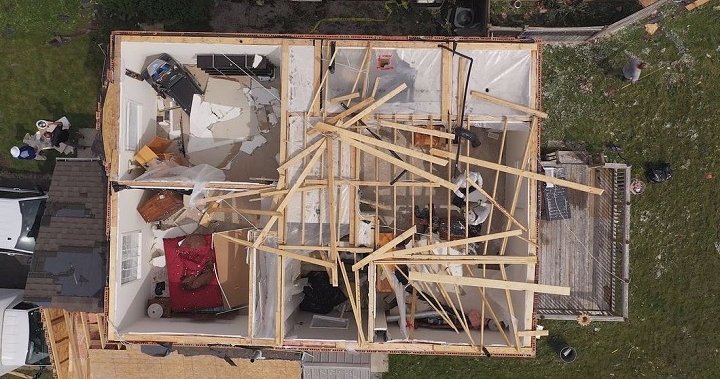

It was the May long weekend in 2022 and Rob Garrard was at his brewery in Uxbridge, Ont., when he heard something he will never forget.
“It’s just this really high-pitched, crazy wind sound,” described Garrard. Moments later a tornado hit his business, The Second Wedge Brewing Company.
“It was like a bomb went off,” Garrard said, “it was devastating.”
The Second Wedge Brewing Company was destroyed in a tornado in May 2022.
Courtesy Joanne Richter
When it was over, shards of glass, metal and tree debris littered the building and area.
“Our roof was literally picked up and flown across the street … and crushed two cars,” he said.
Seconds before the storm, the place was full of customers. It was the first time the business had been open in almost two years because of the pandemic.
When the tornado hit, the staff rushed people into windowless bathrooms.
“I think we were just lucky that no one was seriously hurt,” Garrard told Global News’ The New Reality.
Joanne Richter and Rob Garrard, co-founders and owners of The Second Wedge Brewing Company, inspect the construction at their business after it was destroyed by a tornado in 2022.
Brent Rose/Global News
That EF-2 tornado was part of a derecho, a storm system that travelled about 1,000 kilometres through Ontario into Quebec.
“It killed 12 people … a tragic event,” said Gregory Kopp, who is the lead researcher at the Northern Tornadoes Project (NTP) at Western University in London, Ont.
He added that the storm also “caused more than $1 billion of insured losses.”
Kopp has spent decades trying to make homes more resilient to windstorms. In order to do that, he and the team at NTP have been trying to figure out how many tornadoes occur in Canada every year.
(L to R) Gregory Kopp and Connell Shamus Miller review the destruction caused by a tornado that hit a Barrie neighbourhood in 2021.
Jory Lyons/Global News
Using satellite imagery and radar, the group has discovered Canada gets the second-most tornadoes in the world. In 2022, Canada experienced 117 tornadoes.
“I don’t think many people know that,” Kopp said.
We don’t always see or hear about them because they often strike remote or unpopulated areas.
But when they hit residential neighbourhoods, the damage can be catastrophic.
Kopp explained why it’s vital to keep count.
“It’s actually important, especially … as the population grows and we spread out … what is the true level of risk,” said the civil and environmental engineering professor.
And what is the true level of risk to people’s homes?
To determine that, Kopp and others have been doing testing at the Wind Engineering, Energy and Environment dome, known as WindEEE, which is located just outside of London, Ont., and is part of Western University.
The massive research facility is filled with 106 fans that can simulate a variety of different types of wind systems.
At WindEEE, Girma Bitsuamlak and his team study the aerodynamic forces that develop during different wind systems such as tornadoes, hurricanes and downbursts, so that buildings can be designed to withstand them.
“You can design the building environment appropriately … to withstand the tornado load or at least to save lives,” said Bitsuamlak, who is the director of WindEEE.
WindEEE director, Girma Bitsuamlak, explains to Global News’ Candace Daniel how testing works at the research facility.
Jory Lyons/Global News
Using sensors on a test building, they are able to measure the pressure experienced by a building during a severe windstorm.
Bitsuamlak said they also measure “the velocity magnitude” to determine what kind of speed produced the pressure.
After repeated testing, the results go into a database or get published.
“It is those types of information that are used then to establish building codes,” Bitsuamlak told Global News’ The New Reality.
Making our buildings, especially our homes, more resilient could become vitally important as the effects of climate change worsen.
Over the years, Canadian building codes have shifted to tackle global warming, but the updates have mostly focused on energy efficiency.
Standards geared at changing weather patterns are based on historic records, although codes are continuously under review.
“The weather’s changing. So, designing for the past 50 years prepares us for the past 50 years. It doesn’t prepare us for the next 50 years,” said Keith Porter, who is chief engineer of the Institute for Catastrophic Loss Reduction.
The institute is an independent, not-for-profit research institute that was established by Canada’s property and casualty insurance industry and is affiliated with Western University.
Keith Porter is the chief engineer of the Institute for Catastrophic Loss Reduction.
Jory Lyons/Global News
Porter adds many new homes being built probably won’t be able to handle extreme wind conditions.
“We have known that we could design for tornadoes and just chose not to,” Porter said.
According to the Canadian Board for Harmonized Construction Codes (CBHCC) Canada’s national codes “establish minimum acceptable levels of performance to ensure safety and meet other objectives such as health, accessibility, building protection, and energy efficiency.”
The codes are made available to provinces and territories for implementation, which are responsible for regulating the design and construction of buildings.
Porter said people assume that “if it passed code, it’s good enough.” But home owners don’t always know that passing code doesn’t mean their new home probably can’t withstand a tornado or severe winds.
The aftermath of a house destroyed by a tornado that touched down in Barrie on July 15, 2021.
Morganne Campbell / Global News
“I had no clue,” said Natalie Harris, who survived the 2021 tornado in Barrie, Ont.
She had been at her ex-partner’s house when it hit. Harris and her son took cover in the basement. When she emerged, pink insulation was falling from the sky.
“Oh my God, the roof is gone,” Harris said in the cell phone video she captured of the aftermath.
The twister, which had a maximum wind speed of 210 km/h, ripped through the neighbourhood, peeling roofs off homes and sending debris flying.
Natalie Harris survived the tornado that hit Barrie in 2021. The former city councillor has been advocating for hurricane straps to be included in the building codes since then.
Brent Rose/Global News
Kopp was on the ground within hours to survey the damage, and what he found was a weakness in building performance.
“One of the weakest links on our houses is how the roof is fastened to the walls. And so often in these events, the whole roof comes off and you’re just left there with walls,” he said, who has inspected the aftermath of about 20 tornado-stricken sites.
Hurricane straps
Kopp said a simple solution that could help keep the roof attached during aggressive winds is installing hurricane straps, also known as hurricane clips.
The small bracket is usually installed during new construction. Made of galvanized steel, the hardware is used to strengthen the connection between the roof and the wall.
Kopp said it is also important to make sure “the second floor is attached to the first floor” and the “bottom of the wall is attached properly to the foundation.”
“This technology has been around for a long time,” said Kopp, adding, “We know it works. … It’s just not common here.”
Gregory Kopp shows Global News an example of a hurricane strap and explains how it works.
Jory Lyons/Global News
After the Barrie tornado, Harris started looking into building codes. She was also a city councillor at the time.
Since Barrie had been devastated by a tornado in 1985, Harris was surprised there weren’t more wind resilience guidelines in place.
“I started working … to really try to get to the bottom of why that wasn’t happening in Barrie and how we can change it,” Harris said.
Harris said she backed a proposal to change Ontario Building Codes to have better extreme wind measures, including hurricane straps.
She’s out of politics now but continues to advocate for the measure and has not given up but admits “politics is slow.”
Hurricane straps aren’t mandatory in Canada
The national building code requires each roof-to-wall connection to be fastened by three nails about three inches long called toe nails.
Recently, the code-making system has gone through its own renovation. The national, provincial and territorial governments have agreed to harmonize.
The CBHCC is the committee responsible for developing the National Model Codes in Canada. Global News reached out to the CBHCC to ask whether hurricane straps are being considered to be included in the 2025 National Codes.
In an email statement, the board said: “These requirements are developed considering climatic design data that are based on historical weather observations collected and analyzed by Environment and Climate Change Canada. These data are regularly revised at every code cycle to make sure that the climate change trend is captured in the design of buildings, with forward-looking data under consideration for the 2025 National Model Codes.”
Kopp says a lot of premium builders will use hurricane straps, but because it is not required in the code “it doesn’t get done.”
One argument against adding hurricane straps to the code is cost. Experts say some in the building industry feel the extra expense is not justified.
The price tag of installing hurricane straps can vary depending on the size of the roof and the cost of labour. But the bracket itself can be a few dollars.
Global News’ The New Reality contacted the Canadian Home Builders’ Association, a residential construction industry group with membership of over 8,500 companies, to ask about hurricane straps and whether they should be included in the code.
In an email, the association said:
“Hurricane straps alone are not a ‘silver bullet’. The whole house needs to be considered—you can’t simply add hurricane straps without assessing the impacts on the rest of the structure, or you could have failures in other areas.”
The response added: “Building codes have traditionally and primarily addressed the safety of occupants, and that will need to continue to be the case as the climate changes. Most damage from extreme weather events is to the building rather than injuring people—finding the right balance in terms of code upgrades will be an important engineering process.”
Porter, who has been advocating to get hurricane straps into the code, said one possible solution to ease the financial burden is to spread the cost among governments, builders, owners, lenders and insurance companies.
For example, municipalities could give developers breaks on fees or insurance companies could give discounts to homeowners who have installed hurricane straps.
“We create these incentives in such a way that it becomes less expensive to build new buildings to be resilient,” he said.
Back at The Second Wedge in Uxbridge, we met up with the co-founders and owners, Rob Garrard and his wife, Joanne Richter.
The couple is rebuilding — and this time the brewery will have hurricane straps.
“We’ve gone through all the emotions … in the last year. When we finally started to rebuild, it started to feel better,” Richter said.
Garrard added that they are trying to rebuild their business back better and “safer.”
The two are planning to reopen the brewery on the one-year anniversary of the tornado on the long weekend this month.
While construction won’t be finished, the couple will put up a tent in the garden. They are hoping to see some familiar faces and have life return to normal once again.
“This place is not just a business. … It’s become our home and the customers are part of our family,” Richter said.














